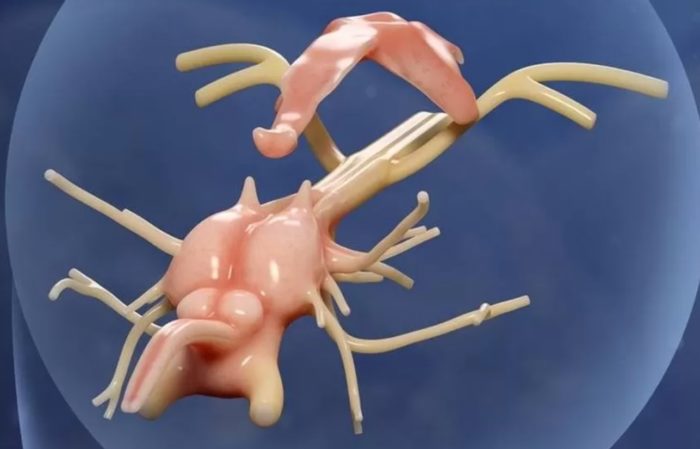Feb 03 2023
Oldest Vertebrate Fossilized Brain
 Researchers report a 3D scan of the oldest vertebrate fossil brain yet discovered – in the head of a 319 million year old ray-finned fish. The specimen was actually found a hundred years ago in a coal mine in England, and has been sitting in a museum draw after it was initially described. It is a skull bone only, and the only specimen of this species (Coccocephalus wildi). New technology now allows us to scan the fossil, peering inside to see the fossilized soft tissue of the brain and cranial nerves. Of course, such a specimen will change the way we view the evolution of the vertebrate brain.
Researchers report a 3D scan of the oldest vertebrate fossil brain yet discovered – in the head of a 319 million year old ray-finned fish. The specimen was actually found a hundred years ago in a coal mine in England, and has been sitting in a museum draw after it was initially described. It is a skull bone only, and the only specimen of this species (Coccocephalus wildi). New technology now allows us to scan the fossil, peering inside to see the fossilized soft tissue of the brain and cranial nerves. Of course, such a specimen will change the way we view the evolution of the vertebrate brain.
As a point of interest, it is not uncommon for paleontologists to make discoveries in museum drawers. Often field work yields many more specimens than can be carefully examined. One summer in the field can haul in a cache that would take many years to properly prepare, reconstruct, and examine. Many specimens therefore sit in drawers without being fully examined. Perhaps they were misidentified at the time, or something interesting about them was missed. It’s also common for statistical examination to be done on vast collections of specimens.
There is also the fact that now we have new and better technology for examining specimens, including non-destructive techniques and scans like CT scans (use in this case) that can look inside specimens in a way not possible before. In a way it is good that there are many neglected specimens, preserved for our current technology to examine.
This specimen is incidentally not the oldest fossilized brain discovered. That title goes to a worm brain described last year that is 525 million years old. But this is the oldest vertebrate brain. Ray finned fish gave rise to most fish groups extant today, but not to the line that lead to land vertebrates – that was lobe finned fish. The last common ancestor between this new specimen and humans was likely around 420 million years ago, at the branching point between ray finned and lobe finned fish. There may therefore be 100 million years of subsequent evolution that separates Coccocephalus and our ancestors. By the time this specimen was swimming around, land animals had been walking around for 70 million years. Even still, there is likely a lot of similarity between this brain and the brain of our fish ancestors.
Also important to this find is the fact that soft tissues like brains only rarely fossilize, primarily because they decay too fast. The researchers speculate that this fish likely was quickly buried in low-oxygen sediment, slowing down decay and providing time for fossilization. On the other hand, even though having soft tissue survive long enough to be fossilized in relatively rare, there are hundreds of millions of years and countless opportunities for this to happen. Now that we have the technology to scan for soft tissue fossils inside of fossils we may discover that it is more common than we thought.
In this case the researcher, Matt Friedman, scanned the fish skull and saw a discrete object inside the skull. This could be just a mineralization, but he was struck by its bilateral symmetry – a clear feature of living organisms. More thorough analysis revealed a clear brain structure with nerves. The fossil brain appears to have three parts – a forebrain, midbrain, and hindbrain, corresponding to the basic anatomy of modern fish brains. It also contains nerves coming out of the sides. They disappear as they exist the skull, suggesting that the microenvironment inside the skull was critical to the fossilization. The brain is also folded inward, which is a “primitive” configuration compared to extant ray finned fish. This could indicate that this common feature among extant ray finned fish evolved later, or that this specimen represents a side branch that retains this primitive feature. Obviously more specimens will help draw the evolutionary lines with greater confidence and detail.
Hopefully we are near the beginning of a new era in paleontology where CT scans and other nondestructive technologies are used to reveal internal soft anatomy. Previously almost everything we knew about extinct species was from their bones. We have occasional other tiny windows into their soft parts – from external impressions (like feather impressions or foot prints) and for more recent species from cave art. Now we have DNA evidence, microfossil evidence (such as preserved proteins), and fossilized soft tissue. This will help us trace the evolution of organs in a way not possible before.






